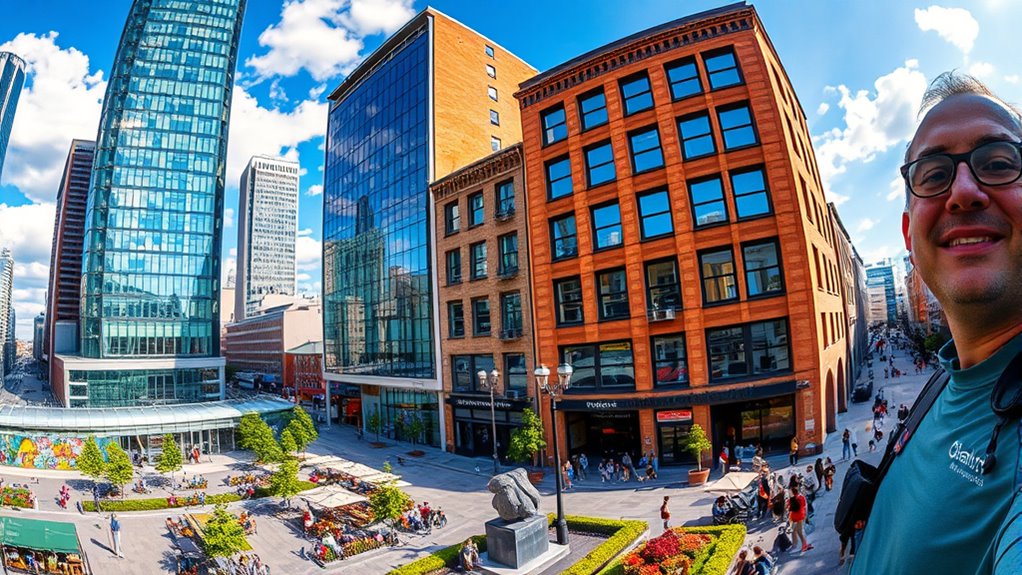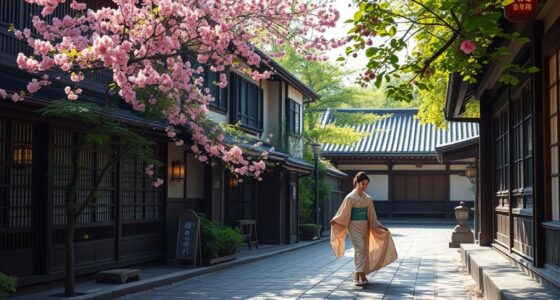Chemnitz 2025 transforms the city into a vibrant hub of cultural innovation, blending its industrial heritage with modern artistic projects. You’ll experience around 1,000 events, from exhibitions and concerts to public art and community-driven initiatives. The theme “C the Unseen” uncovers hidden layers of the city and its regions. If you want to explore how Chemnitz combines heritage, creativity, and sustainability, there’s much more to discover ahead.
Key Takeaways
- Chemnitz is designated as the European Capital of Culture 2025, spotlighting its industrial and artistic heritage.
- The city hosts around 1,000 diverse cultural events, including exhibitions, concerts, and festivals, throughout 2025.
- The theme “C the Unseen” explores hidden layers of Chemnitz’s industrial history and regional landscapes.
- Innovative public art and digital projects, such as murals and online archives, enhance cultural accessibility and engagement.
- Cross-border collaborations and regional initiatives aim to foster sustainable growth and cultural exchange beyond 2025.
Chemnitz’s Role as a European Capital of Culture in 2025
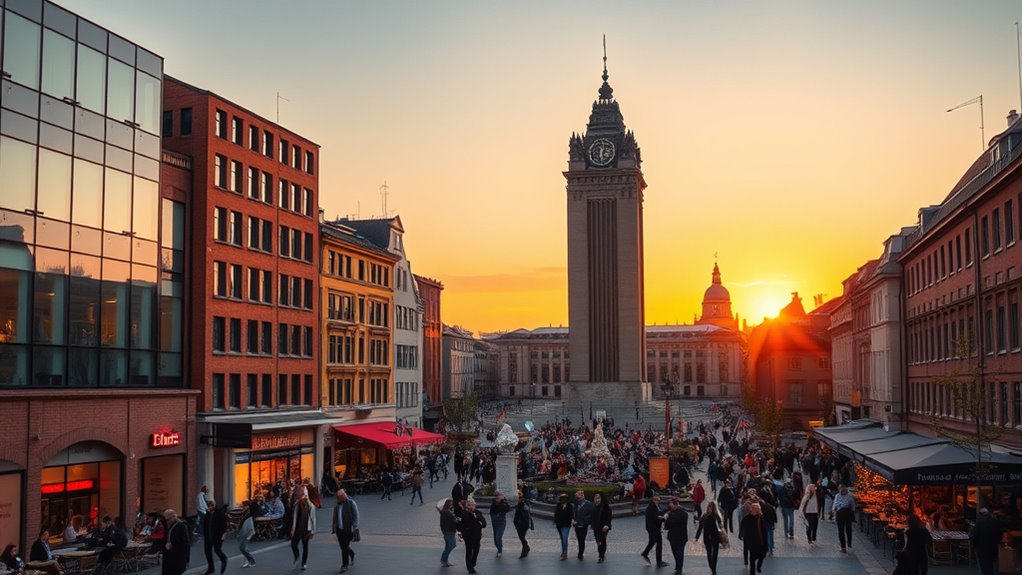
Chemnitz is stepping into a prominent cultural spotlight in 2025 as the European Capital of Culture, a title that underscores its rich industrial and artistic heritage. As a key part of this role, you’ll find digital archives showcasing the city’s history, making its cultural evolution accessible to everyone. These archives help you explore the city’s industrial past alongside its vibrant arts scene. Additionally, Chemnitz celebrates its culinary traditions, highlighting regional flavors through special festivals and events. This focus on food offers you an authentic taste of local culture, connecting history with contemporary practices. The combination of digital archives and culinary traditions invites you to experience Chemnitz’s unique identity fully, emphasizing its significance as a hub of creativity, history, and regional pride during this landmark year. Incorporating cultural preservation initiatives, the city aims to sustain its artistic legacy for future generations.
Thematic Focus: “C the Unseen” and Regional Highlights
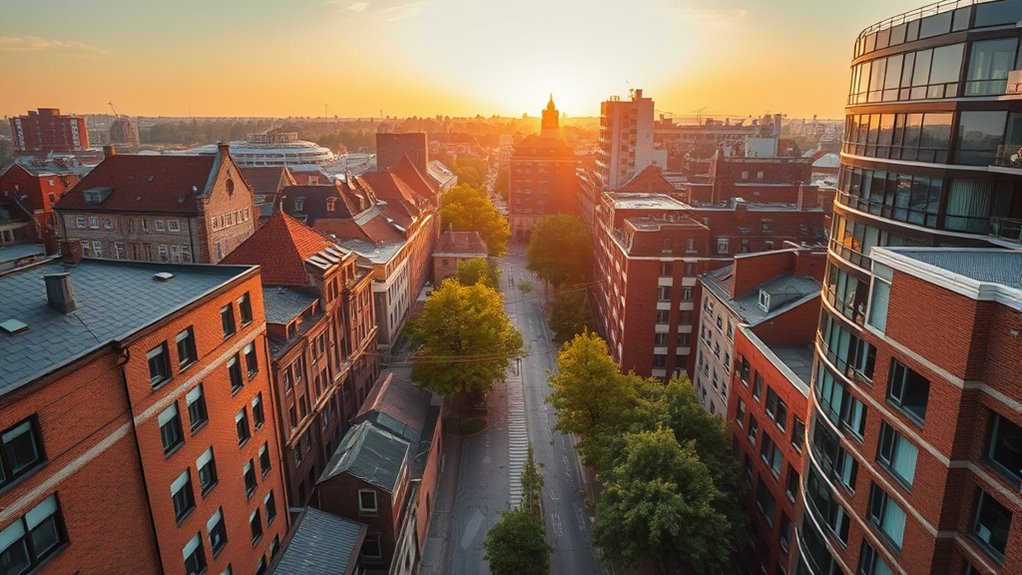
As Chemnitz embraces its role as the European Capital of Culture in 2025, a compelling theme emerges: “C the Unseen.” This focus aims to uncover hidden layers of the city and its surrounding regions, inviting you to explore aspects often overlooked. You’ll discover Hidden Narratives within regional highlights like Central Saxony’s industrial past, the scenic Ore Mountains, and the vibrant Zwickau Region. The theme emphasizes Urban Evolution, transforming old garages into creative spaces and integrating art trails like the Purple Path. Community involvement is central, encouraging participation in workshops and neighborhood projects. By exploring these unseen facets, you’ll gain a deeper understanding of Chemnitz’s rich history, cultural revival, and regional diversity, including the region’s diverse cultural and regional identity, revealing the city’s evolving identity beyond its well-known landmarks. Recognizing the importance of sustainable practices, the city also promotes innovative solutions like Self Watering Plant Pots to enhance green urban development.
Cultural Events and Participatory Community Projects

You’re invited to participate in Chemnitz’s vibrant community-driven art initiatives and inclusive festival programs. These projects actively involve residents in shaping the city’s cultural landscape through workshops and collaborative events. How can such participatory efforts strengthen community bonds and foster a shared sense of ownership? Engaging in creative practice can empower community members to contribute their unique talents and perspectives, further enriching the cultural fabric of the city.
Community-Driven Art Initiatives
Community-driven art initiatives in Chemnitz 2025 foster active participation and strengthen local ties by transforming everyday spaces into vibrant hubs of creativity. Through urban renewal projects like upgrading garages into mini-art spaces, you can see how artistic entrepreneurship sparks new opportunities for community engagement. The public mural program by Halienkunst beautifies neighborhoods while involving locals in shaping their environment. Digital art initiatives, using mobile devices, encourage collaborative creativity and expand access to art-making. The transformation of the Silver Smelter into a creative laboratory exemplifies how industrial sites become centers of innovation. These initiatives not only revitalize neighborhoods but also empower residents to take ownership of their cultural landscape, making Chemnitz a thriving, participatory hub where art is a catalyst for community renewal. The integration of AI security can further support these initiatives by safeguarding digital platforms and protecting community-created content, ensuring a secure environment for creative expression. The city’s history as a textile and industrial hub also inspires contemporary creative projects that connect past and future.
Inclusive Festival Programming
Chemnitz 2025’s vibrant cultural scene thrives through its inclusive festival programming, engaging residents and visitors alike in a wide array of events. You’ll experience over 1,000 diverse happenings, from theatre and art exhibitions to concerts and dance parties. Digital storytelling plays a key role, allowing communities to share their unique narratives through interactive media, fostering a sense of belonging. Data-driven insights can further enhance event planning and community engagement by understanding attendee preferences and improving resource allocation. Food innovation is also celebrated, with festivals like the EuroBean Chocolate Festival offering creative culinary delights that unite people around shared tastes. These events encourage community participation, transforming city areas into cultural hubs where everyone can contribute. By blending cutting-edge technology, culinary creativity, and collaborative spirit, Chemnitz creates an inclusive atmosphere that highlights its regional diversity and European connections.
Participatory Cultural Workshops
Participatory cultural workshops energize Chemnitz’s vibrant scene by actively engaging community members in shaping local culture. They do this through active community involvement, fostering collaboration across generations and borders via cultural diplomacy. These workshops utilize digital outreach to connect local residents with European partners, expanding networks and sharing ideas. Supported by the Federal Agency for Civic Education, they focus on transforming concepts into tangible projects, strengthening local skills and capacities. Workshops often include educational programs, project support, and exchanges that promote diversity and civic engagement. By involving residents directly in planning and implementation, these initiatives ensure community ownership. The team(team(at)chemnitz2025.de) facilitates these activities by coordinating efforts and providing guidance, ensuring the workshops’ success. Events like intercultural weeks and maker residencies showcase Chemnitz’s cultural richness while reinforcing its role as a dynamic hub for creativity and cooperation across Europe. Furthermore, incorporating elements of cultural intelligence into these workshops enhances participants’ understanding and appreciation of diverse cultural perspectives, fostering more meaningful intercultural exchanges.
Key Artistic and Exhibition Initiatives
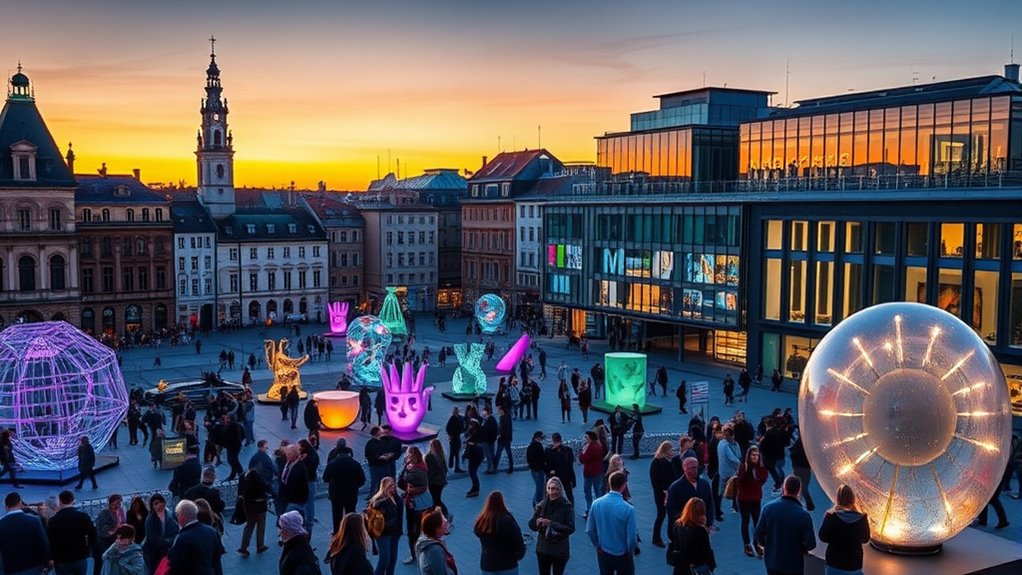
In 2025, a diverse array of artistic and exhibition initiatives will showcase both European and local creativity, transforming Chemnitz into a vibrant hub for cultural exchange. Digital curation plays a key role, connecting artworks across venues and enabling immersive online experiences. Major exhibitions like “European Realities” and “Edvard Munch. Angst” highlight diverse art movements and themes, engaging visitors with interactive displays such as the “Pavilion of Fear.” Artistic collaborations also thrive through flagship projects like “#3000GARAGES,” which blend photography, multimedia, and local garage culture. The IBUG urban art festival transforms abandoned industrial sites into dynamic canvases, fostering community engagement. These initiatives foster cross-disciplinary dialogue, elevate local talent, and embed Chemnitz firmly within Europe’s contemporary art scene. Approximately 1,000 cultural events held annually in Chemnitz also reflect the city’s dedication to cultural diversity and vibrancy. Additionally, the integration of **Digital curation** enhances the accessibility and reach of these exhibitions, allowing a broader audience to experience the city’s vibrant art scene.
Exploring Chemnitz’s Industrial Heritage and Modern Identity
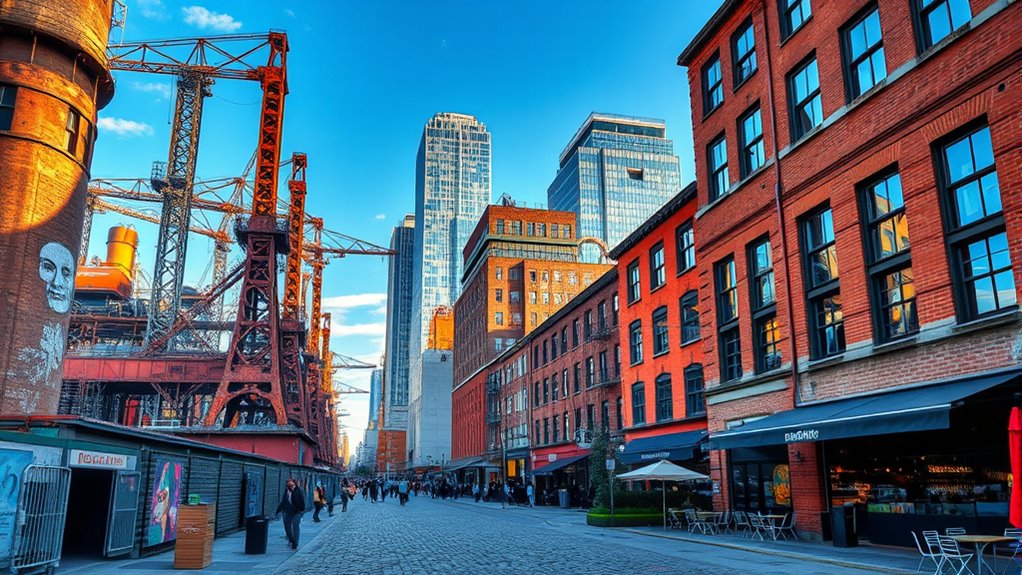
You can see Chemnitz’s industrial roots in its historic factories and landmarks that still shape the cityscape. These symbols of its past are now being reimagined as part of its modern identity. As the city transforms, it balances preserving its industrial legacy with embracing new cultural and innovative developments. Incorporating cultural preservation efforts helps maintain the city’s unique character amidst rapid change.
Industrial Roots and Revival
Chemnitz’s industrial heritage runs deep, shaping its modern identity through a legacy of innovation and resilience. The city’s industrial evolution began with early roots like the 1357 bleaching privilege, which made Chemnitz a textile hub, and the first mechanized cotton mill in 1799. By the 19th century, Chemnitz earned the nickname “the Saxon Manchester,” reflecting its textile and engineering dominance, supported by heritage preservation of its machine tool manufacturing, established in 1848. The city experienced rapid growth, with a population boom and diversification into iron, rails, and mining. Despite setbacks during deindustrialization after reunification, Chemnitz’s history of innovation remains a foundation for revival efforts today, blending its industrial past with a renewed focus on sustainable growth and technological advancement. Additionally, efforts to preserve industrial heritage have become integral to the city’s cultural identity and tourist appeal.
Historic Landmarks and Symbols
Historic landmarks and symbols vividly showcase Chemnitz’s industrial heritage while shaping its modern identity. The Villa Esche, designed by Henry van de Velde, exemplifies early 20th-century industrialist patronage of art and architecture, reflecting heritage preservation efforts. The König Albert Museum stands as a symbol of industrial wealth supporting cultural growth. The Kaßberg district’s well-preserved Art Nouveau residential architecture highlights Chemnitz’s industrial prosperity. The Chemnitz Museum of Industry, housed in a former foundry hall, offers interactive exhibits like steam engines and textile machinery, linking past achievements to today’s innovations. Railway museums, including the Chemnitz-Hilbersdorf station, preserve industrial transportation history. These landmarks and symbols vividly portray the city’s industrial architecture and heritage, connecting Chemnitz’s storied past with its evolving modern identity. Additionally, industrial heritage sites play a crucial role in maintaining the city’s cultural legacy while attracting tourism and educational opportunities.
Modern Cultural Transformation
The city’s industrial heritage forms the backbone of its modern cultural transformation, shaping how Chemnitz redefines its identity today. You see, industrial innovation and heritage preservation go hand in hand as the city repurposes old spaces into vibrant cultural venues. Over 30,000 GDR-era garages now serve as exhibition halls and community centers, blending past and present. Brownfield redevelopment revitalizes abandoned sites, fostering new artistic expressions and local engagement. Chemnitz balances celebrating its industrial roots with contemporary art, hosting exhibitions on mining history alongside modern sculpture trails. This adaptive reuse of industrial architecture bridges working-class traditions with innovative creativity, helping the city forge a fresh identity while honoring its heritage. Your experience of Chemnitz’s transformation reflects a city committed to preserving its past while embracing the future. industrial heritage continues to influence the city’s evolving landscape, fostering a unique sense of place.
The Impact on Local Economy and Social Cohesion
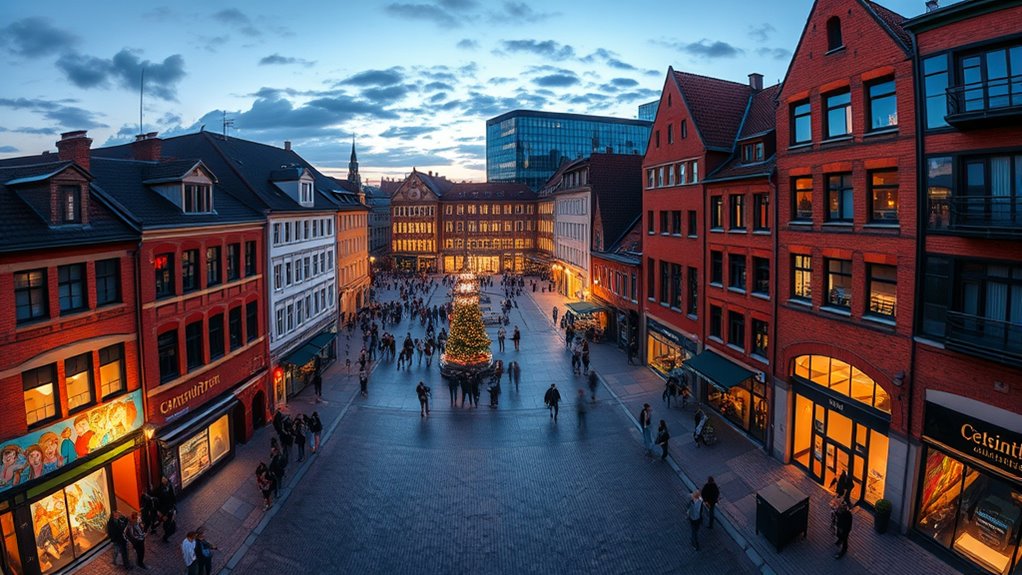
As European Capital of Culture 2025, Chemnitz aims to transform its economy and strengthen social bonds through targeted cultural initiatives. You’ll see efforts to promote economic diversification by supporting creative industries and cultural entrepreneurship, which create new jobs and business opportunities. Urban infrastructure improvements, such as revitalized public spaces, help attract tourists and boost local spending in hospitality and retail sectors. These projects are designed to enhance the city’s appeal and encourage long-term economic growth. Social cohesion is also a focus, with grassroots programs and community storytelling fostering inclusivity and mutual understanding. By engaging residents and regional partners, Chemnitz nurtures a shared identity, helping to overcome past divisions. Additionally, eye patch benefits like hydration and anti-aging effects exemplify how targeted interventions can improve individual well-being, parallel to community-focused initiatives. Overall, these initiatives aim for a sustainable, vibrant economy and a more united community.
Notable Public Art and Cultural Installations
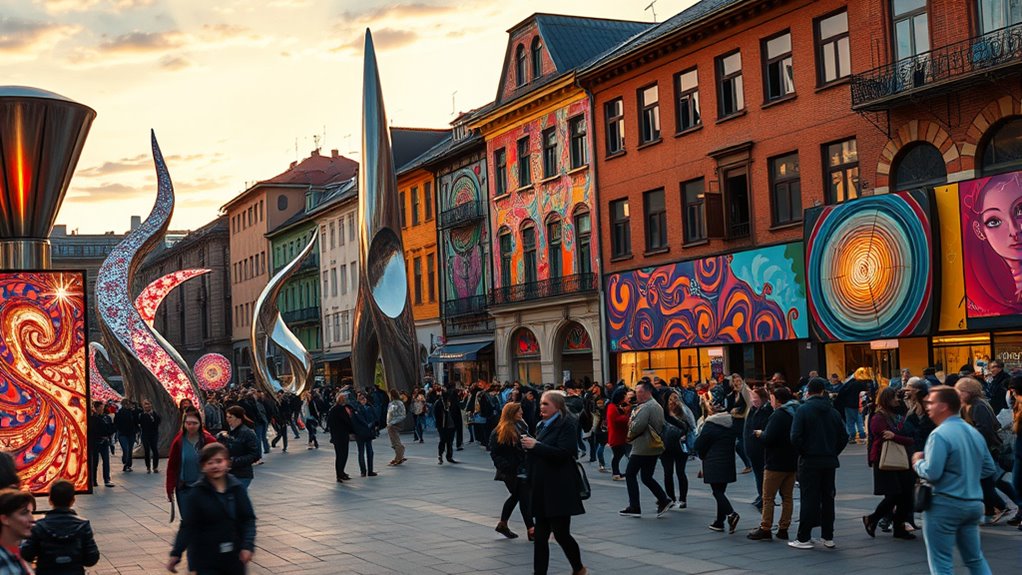
Chemnitz’s public art and cultural installations are transforming the city into a vibrant outdoor gallery that celebrates creativity and history. The Public Mural Art Program, supported by local institutions, will feature eight facades and public spaces designed by international artists in 2024. This initiative elevates urban aesthetics through vibrant murals and graffiti techniques, turning spaces like Johannisplatz into modern art hubs. As you explore, you’ll notice:
Chemnitz transforms into an outdoor gallery with vibrant murals and innovative street art in 2024.
- The integration of contemporary street art with historic surroundings
- Notable works by graffiti artist MadC emphasizing urban aesthetics
- The transformation of industrial sites into open-air galleries, blending rugged heritage with innovative art
- The spiritual significance of colors and symbols incorporated into some murals, adding layers of meaning and cultural depth
These installations create a dynamic visual landscape, showcasing Chemnitz’s evolving cultural identity and embracing street art as a essential part of its creative future.
Future Directions: Legacy and Policy Innovations
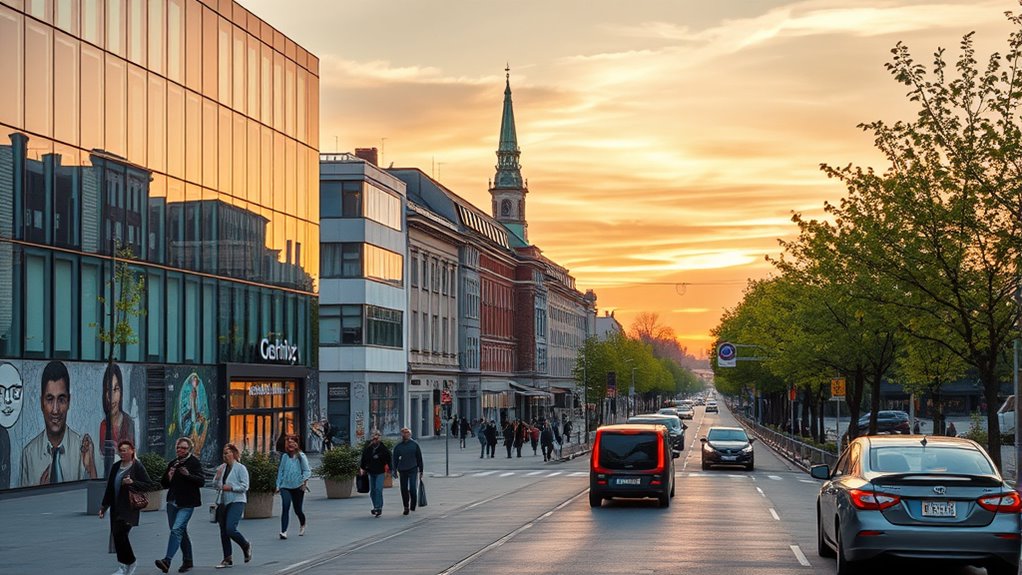
Community empowerment drives Chemnitz 2025’s legacy-building efforts, ensuring that local residents shape and sustain cultural initiatives long after the event concludes. By co-creating programs that reflect their cultural needs, you foster grassroots engagement and inclusive participation. Policy innovations, such as a white paper with 40 recommendations, aim to reform European Capital of Culture frameworks, emphasizing participatory governance and regional partnerships involving 38 municipalities. Digital innovation plays a pivotal role, supporting cultural entrepreneurship through maker hubs and creative industries, like fashion and textiles festivals. These initiatives promote sustainable urban growth, economic resilience, and long-term cultural identity. By embedding legacy measures and encouraging citizen-led projects, Chemnitz sets a precedent for a vibrant, inclusive, and innovative cultural future that extends beyond 2025. Additionally, understanding cultural ingredients such as the integration of local traditions and modern practices can further strengthen community bonds and authenticity.
Collaborations and Regional Cultural Strategies
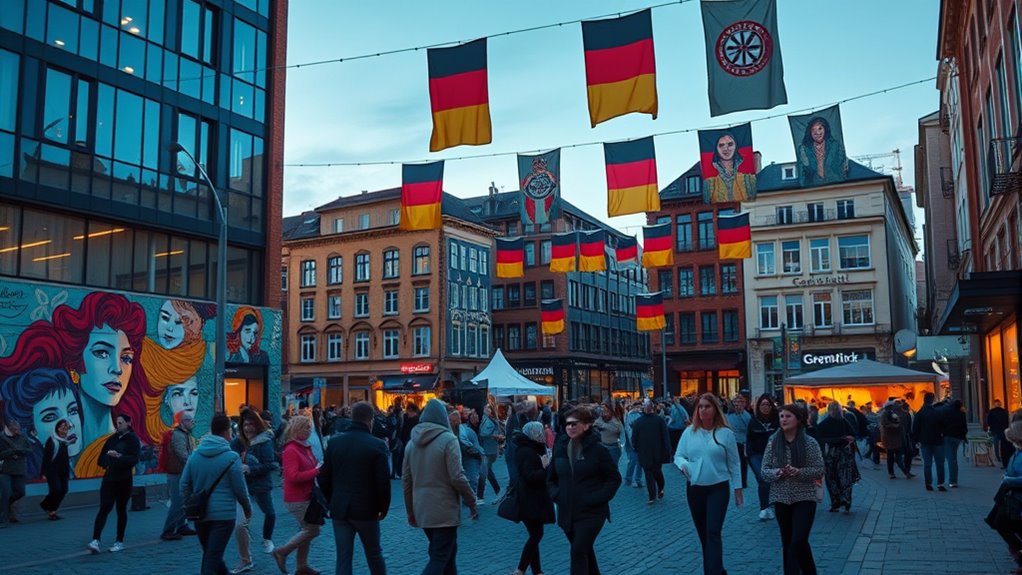
Collaborations and regional cultural strategies form the backbone of Chemnitz 2025’s approach to creating a vibrant, inclusive cultural landscape. You’ll see how digital innovation and cross-sector partnerships drive this effort. For example:
Collaborations and regional strategies are essential to fostering a vibrant, inclusive cultural landscape through innovation and partnership.
- The Makers United festival fosters cross-border cooperation with Nova Gorica, promoting digital fashion and textile innovation.
- Nine maker hubs across sectors like textiles and culinary arts attract international talent and tourists, encouraging joint creative work.
- The regional strategy unites 38 municipalities, blending history, industry, and culture through projects like the Purple Path art trail.
- Emphasizing the importance of projection technology, these initiatives aim to enhance visual storytelling and audience engagement across cultural venues.
These collaborations empower local and international partners, supporting citizen-driven programming and fostering long-term cultural growth. It’s about connecting sectors, sharing knowledge, and amplifying regional stories in innovative ways.
Frequently Asked Questions
How Will Chemnitz Sustain Its Cultural Legacy Beyond 2025?
You can maintain Chemnitz’s cultural legacy beyond 2025 through a focus on cultural preservation and artistic innovation. By supporting community-driven projects, ongoing exhibitions, and regional collaborations, you guarantee that local stories and heritage remain vibrant. Promoting new artworks, festivals, and inclusive initiatives keeps the city culturally dynamic. This active engagement helps embed culture into daily life, creating a lasting impact that continues to inspire and attract visitors long after 2025.
What Specific Community Projects Engage Marginalized Groups in Chemnitz?
Oh, because marginalized groups just love feeling invisible, right? Well, not in Chemnitz! You’re actively involved in community outreach and inclusive programming that genuinely engages these groups. You help create safe spaces, foster dialogue, and support queer networks, ensuring everyone’s voice matters. Through artistic projects and collaborations, you’re making sure that marginalized communities aren’t just seen but celebrated—turning Chemnitz into a truly inclusive hub of cultural diversity.
How Does the “C the Unseen” Theme Influence Local Artistic Expressions?
You see how the “C the Unseen” theme shapes local art by highlighting hidden narratives and giving voice to silent voices. It encourages artists to explore unseen talents, forgotten places, and lesser-known stories, making the invisible visible through innovative expressions. This influences your community’s artistic scene by fostering deeper connections, promoting diversity, and revealing the city’s quiet cultural vibrancy, inspiring everyone to engage with stories waiting to be uncovered.
In What Ways Are Regional Municipalities Involved in the Cultural Initiatives?
You might think regional municipalities aren’t involved in cultural initiatives, but they play a crucial role through municipal collaboration and regional funding. They support micro-projects, promote local stories, and coordinate large regional events, ensuring diverse communities engage with culture. By contributing venues, resources, and organizing civic dialogues, municipalities help create a vibrant, inclusive cultural landscape that reflects regional identity and fosters community participation across the area.
What Long-Term Economic Benefits Are Expected From Chemnitz’s Cultural Year?
You can expect long-term economic benefits like a tourism boost and increased business investment. The cultural year will attract visitors year-round, supporting local hospitality and retail. It also encourages private investment in creative industries and urban regeneration projects, fueling job creation and economic growth. As a result, Chemnitz’s vibrant cultural scene will strengthen its economic resilience, making it a more dynamic and attractive city for residents, entrepreneurs, and international visitors alike.
Conclusion
As you explore Chemnitz’s vibrant cultural scene in 2025, you’ll see how it truly puts its best foot forward. The city’s innovative events and community-driven projects showcase its unique blend of history and modernity. This year isn’t just a flash in the pan—it’s a stepping stone toward a lasting legacy. Keep your eyes open, because when the dust settles, Chemnitz proves it’s ready to shine and leave a mark that’s hard to ignore.
